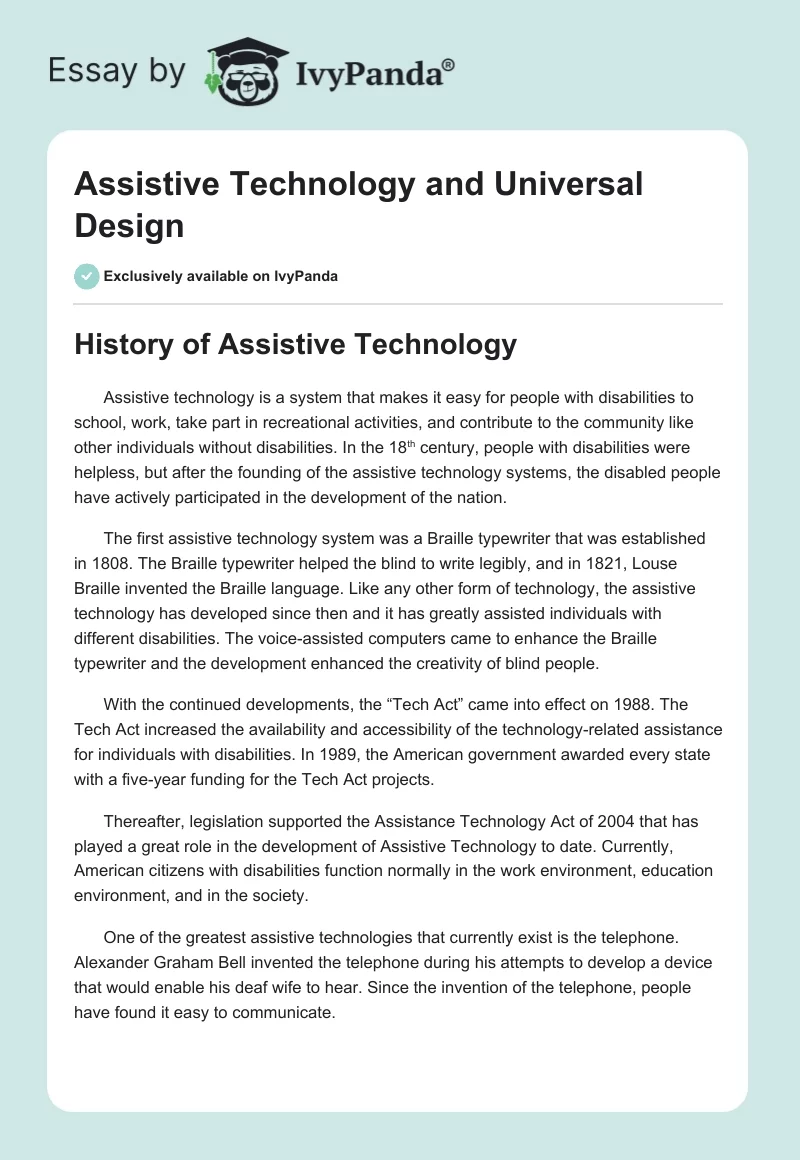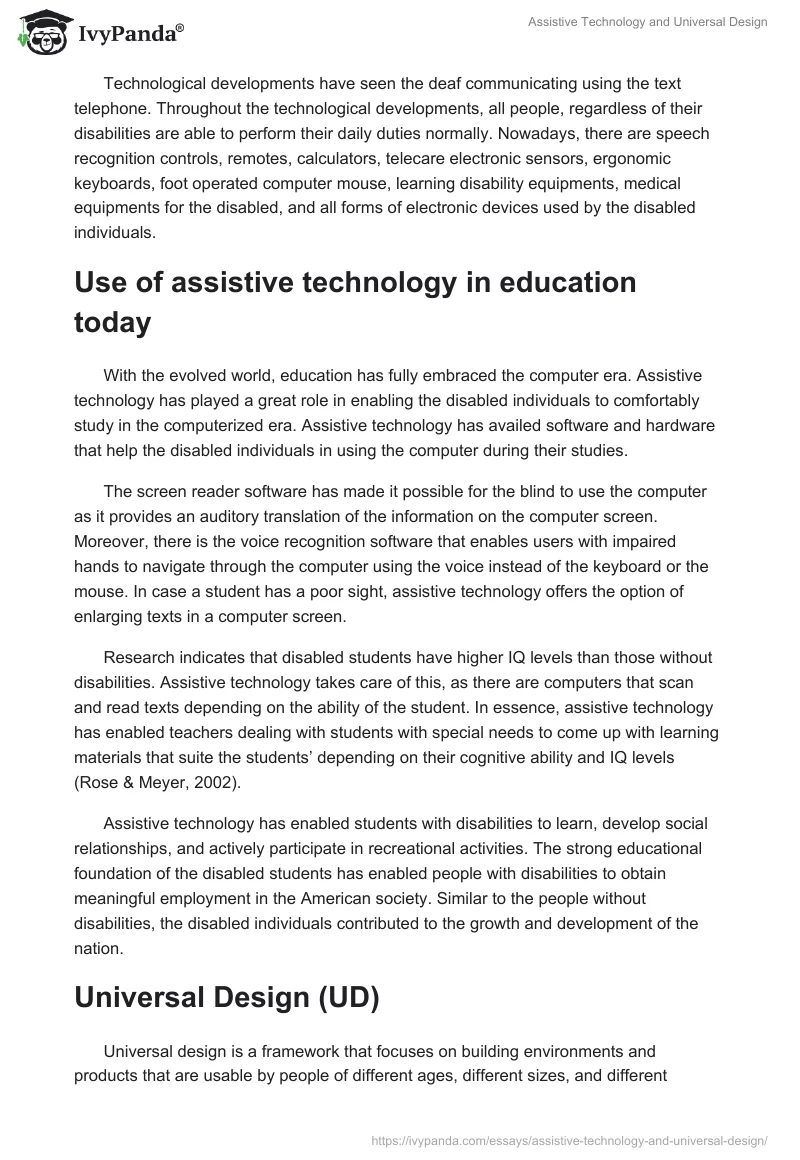History of Assistive Technology
Assistive technology is a system that makes it easy for people with disabilities to school, work, take part in recreational activities, and contribute to the community like other individuals without disabilities. In the 18th century, people with disabilities were helpless, but after the founding of the assistive technology systems, the disabled people have actively participated in the development of the nation.
The first assistive technology system was a Braille typewriter that was established in 1808. The Braille typewriter helped the blind to write legibly, and in 1821, Louse Braille invented the Braille language. Like any other form of technology, the assistive technology has developed since then and it has greatly assisted individuals with different disabilities. The voice-assisted computers came to enhance the Braille typewriter and the development enhanced the creativity of blind people.
With the continued developments, the “Tech Act” came into effect on 1988. The Tech Act increased the availability and accessibility of the technology-related assistance for individuals with disabilities. In 1989, the American government awarded every state with a five-year funding for the Tech Act projects.
Thereafter, legislation supported the Assistance Technology Act of 2004 that has played a great role in the development of Assistive Technology to date. Currently, American citizens with disabilities function normally in the work environment, education environment, and in the society.
One of the greatest assistive technologies that currently exist is the telephone. Alexander Graham Bell invented the telephone during his attempts to develop a device that would enable his deaf wife to hear. Since the invention of the telephone, people have found it easy to communicate.
Technological developments have seen the deaf communicating using the text telephone. Throughout the technological developments, all people, regardless of their disabilities are able to perform their daily duties normally. Nowadays, there are speech recognition controls, remotes, calculators, telecare electronic sensors, ergonomic keyboards, foot operated computer mouse, learning disability equipments, medical equipments for the disabled, and all forms of electronic devices used by the disabled individuals.
Use of assistive technology in education today
With the evolved world, education has fully embraced the computer era. Assistive technology has played a great role in enabling the disabled individuals to comfortably study in the computerized era. Assistive technology has availed software and hardware that help the disabled individuals in using the computer during their studies.
The screen reader software has made it possible for the blind to use the computer as it provides an auditory translation of the information on the computer screen. Moreover, there is the voice recognition software that enables users with impaired hands to navigate through the computer using the voice instead of the keyboard or the mouse. In case a student has a poor sight, assistive technology offers the option of enlarging texts in a computer screen.
Research indicates that disabled students have higher IQ levels than those without disabilities. Assistive technology takes care of this, as there are computers that scan and read texts depending on the ability of the student. In essence, assistive technology has enabled teachers dealing with students with special needs to come up with learning materials that suite the students’ depending on their cognitive ability and IQ levels (Rose & Meyer, 2002).
Assistive technology has enabled students with disabilities to learn, develop social relationships, and actively participate in recreational activities. The strong educational foundation of the disabled students has enabled people with disabilities to obtain meaningful employment in the American society. Similar to the people without disabilities, the disabled individuals contributed to the growth and development of the nation.
Universal Design (UD)
Universal design is a framework that focuses on building environments and products that are usable by people of different ages, different sizes, and different abilities. The universal design intends to make inclusive and lifespan designs for all individuals. There are various principles that guide universal designs.
- Equitable use: The design must be useful, marketable, and useable with individuals with diversified disabilities.
- The design must be flexible to have room for individuals with different disabilities.
- The design must be simple to use such that even inexperienced individuals can easily use the products and services.
- The design of the products must be able to provide discerned information depending on the user’s sensory ability.
- The design of the products must have the potentiality to minimize the consequences of accidents or unintended actions.
- Low physical effort: The design must be efficient in its usage, such that users need minimum physical effort to operate the machinery.
- Size and space for approach and use: The design must be have the appropriate size depending on the use of the machine. The size should accommodate all users regardless of their posture, body size, or mobility (Burgstahler, 2007).
The seven elements of the UD base their roots on the principles of UD. The elements listed below seek to define the necessary assessments needed when dealing with disabled students.
- Population assessment: This element assesses the students to ensure they have equal access to the UD benefits.
- Defined constructs: This element ensures the presence of distinct education constructs that help in the decision making exercise.
- Non-biased items: This element ensures all disabled students benefit equally without prejudicing a particular group.
- Accommodation: This element ensures that there is an open access to accommodation for all disabled students.
- Simple instructions and procedures: This element ensures that students’ ability is gauged using simple tests.
- Maximum readability and comprehensibility: The element ensures that texts and tests presented to disabled students are not complex.
- Maximum legibility: The element ensures that the learning method is easily deciphered.
The above-mentioned elements and principles of universal design have applied in various aspects of the current education system. The universal designs have ensured that students’ services and equipments are able to serve all disabled students.
Universal Designs have applied in various educational products such as computers equipments, software, study websites, study textbooks, and even the lab equipments (Bar & Galluzzo, 2009). In designing the school environment, designers employ the Universal Design elements to ensure dormitories, classrooms, libraries, and all school buildings are equitable and flexible in use. The Universal Designs advocates for automatic doors, ramps, and curb cuts in buildings to facilitate the movement of disabled individuals.
With the help of computer technology, the universal design works towards creating an educational environment that enables disabled students to use minimal Assistive Technology. With the combination of assistive technology and the universal designs, teachers can teach using different methods and materials.
The students can actively participate in learning exercises; they can express their views and present their assignments in different formats. Generally, universal design and assistive learning have played a great role in enhancing education for students with disabilities. The technological developments are still in progress, and in the near future, the disabled individuals will be able to disregard their disabilities and stand tall for their immense contributions in the society.
References
Bar, L., & Galluzzo, J. (2009). The accessible school: Universal design for educational settings. Berkeley, CA: MIG Communications.
Burgstahler, S. (2007). Equal access: Universal design of student services. Seattle: University of Washington.
Rose, D. H., & Meyer, A. (2002). Teaching every student in the digital age: Universal design for learning. Alexandria, VA: Association for Supervision and Curriculum Development.


